1 The Origins of the Surname Nurse
1.1 Introduction
The primary goal in any family history research is to try and determine where the family originated. Sometimes, one is lucky and can accomplish this goal by pursuing the original records – birth/baptism, marriage, death/burial, wills and probate, but more often than not records are either lost or so illegible that the researcher reaches a dead end.
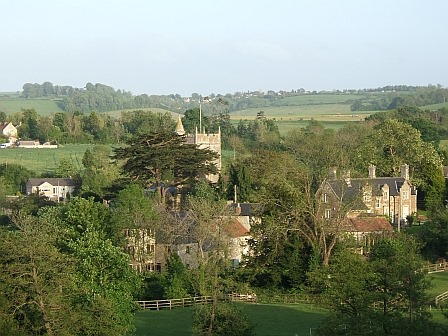
This happened to me when researching my Nurse lineage. I managed to trace the family origins with a high degree of confidence to the parish of Compton Dando (“Compton Dando” 2023) in northern Somerset, the first reference in that parish being the baptism of James Nurse, son of William and Sarah Nurse on 15th June 17351.
A thorough review of the parish records for the parishes of north Somerset (see Figure 1.2) showed that the family probably moved to Compton Dando from the area around Chew Magna (“Chew Magna” 2023) i.e. Chew Stoke,2 Chew Magna,3 and Norton Malreward4, to the south west of Compton Dando parish, and later I will show how I was able to push my Nurse ancestry back at least one more generation to that area.
There are a number of references to Nurse’s living in Chew Magna, the earliest reference in the parish being the burial of Joane Nurse of Stoke in 1573.
Joane Nurse of Stoke was buried on 19 Nov 1573.
At that time Chew Stoke was part of the parish of Chew Magna. However, due to the poor state of the original records as well as their incompleteness, these conclusions are quite tentative and my research into the Nurse line came to a grinding halt.
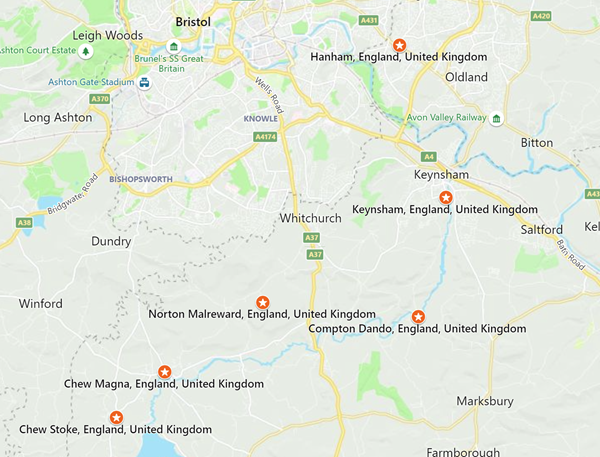
The next stage in determining a family’s origin is to carry out research on the origin of the surname, with the hope that it can be shown that the name must have originated from a single source. This is actually very rare, but in the case of Nurse we can develop a few possible scenarios.
So, what is the origin of the surname Nurse?
I will take two different approaches to this question.
- The first approach will be to study the etymology of the name, to determine if there is a unique source.
- The second approach will be a statistical geographical approach. Through the use of various records we can attempt to determine the geographic location of the surname.
There is a third approach that can be used to trace your paternal ancestry (which in effect is what tracing the history of your surname is) and that is to use DNA. This type of research is still in its infancy but can be used to confirm that male descendants with a common surname have a common Ancestor.
1.2 The Origin of Surnames

Only a few families can truly trace their surnames to the “Domesday Book”, and even fewer can go back even tentatively to the pre-Conquest Anglo-Saxon era. The only families that have been able to prove an ancestry to Anglo-Saxon ancestors are the Arderns from Aelfwine and the Berkleys from Eadnoth.
Mainly this is due to a lack of records, but for most of us, it is also due to the fact that hereditary surnames were restricted to the great land owning families. The average person did not need a family name, as they lived in villages where everyone knew your name.
Most of these early hereditary surnames were derived from the locality where the family had their chief residence. For example, amongst William I’s barons at Hastings were William de Warenne from Varennes near Dieppe, Roger de Busli from Bully-en-Brai near Neufchatel and Ilbert de Laci from Lassy, south of Bayeux. These Norman barons introduced the concept of hereditary surnames, which slowly spread to the rest of the population
During the two centuries or so that followed the Conquest most major landowning families and many knights adopted hereditary surnames, especially if they lived in the south of England, most of these hereditary surnames being derived from the place of origin of the family.
Later in the Middle Ages everyone began to adopt hereditary surnames. One of the largest categories of surnames is that which is derived from personal names. Some of these surnames, such as Paul or Thomas, derive directly from the personal name of the father of the man, who was the first in that line to adopt a hereditary surname. Others have –s or –son added as a suffix to a personal name, e.g. Roberts, Williams, Jones (son of John) or Johnson, and yet others are prefixed by the Norman Fitz-, the Gaelic Mac or Mc, or the Welsh ap or ab, all of which mean “son of”.
Finally, another large group of surnames, which became popular amongst the lower classes, is derived from occupations or from an office, rank or status. By the beginning of the thirteenth century, the more common occupational surnames, such as Smith, Taylor or Wright were already quite numerous. (see Hey 1993, 15–21)
1.3 Etymology of the Surname Nurse
So let’s take a look at how the surname Nurse could have originated.
It appears that the surname Nurse is derived from the same origins as the related names Nursey, Nourse, Norrish, Nurrish, Nowers, Norreys, Norrie and Norris, with the last being the form most common in recent times. The earliest mention of the variant Nurse appears to be in the 14th century.(see Reaney 1958, 232) There appears to be four different origins for this family of names. (Reaney 1958, 231, 232)
The first origin is derived from the Old French word “norreis” which means “northerner” or “northman”. This version of the name was found all over the country but particularly in the Midlands and the South. Some examples are;
- Robert Noreis, who lived in Winton, Hampshire in 1148, (Reaney 1958, 231)
- William Le Norreis who lived in Seals, Gloucestershire between 1163 and 1200, (Reaney 1958, 231)
- Robert Le Norais who lived in Yorkshire in 1170, (Reaney 1958, 231)
- Robert Le Norreis who witnessed a charter by Earl Gospatric to the Priory of Coldingham in Scotland in 1166, (Black 1946, 632) and
- William Norrensis5 who witnessed a charter by Malcolm, Earl of Fife in 1228. (see Black 1946, 632)
A second related, but far less common derivation is derived from the Old English words “noro” (north) and “hus” (house) meaning someone who dwelt in the north house or someone who lived on the north side of the estate, e.g.
- Adam de Northus who lived in Essex in 1206. (Reaney 1958, 231)
The third origin of the name, which is again quite common, is from the Old French word “norice”, or “nurice” and the Latin “nutrix”/“nutricis” meaning wet nurse or foster parent. Again this version of the name is widespread throughout the country. Examples of people with the name with this origin are:
- John “Le Norreys” who was one of an inquisition to inquire if Walter Biset was seized in the manor of Ulvington, Scotland at his death in 1251, (Black 1946, 632)
- Richard Norreys of Berwickshire who rendered homage to the King in 1296, (Black 1946, 632)
- Robert Le Noris of Yorkshire in 1297, (Reaney 1958, 231)
- Alice La Norisse in Essex in 1310, (Reaney 1958, 231) and
- John Norice in Kent in 1317. (Reaney 1958, 231)
The last origin of this family of names is derived from a family that came from Normandy with William the Conqueror; de Noers (and its variations, de Noiers, de Nuers). It is this last variation that most closely resembles the name Nurse, requiring only one letter to be moved.
At least one soldier named “de Noers” came with William the Conqueror and is on the Roll of Battle Abbey, in the Domesday Book. (see Cleveland 1889, 2:341) The actual derivation of this name seems to be “de Noyers” after the name of a place –“Noyers”- in Normandy, between Rouen and Paris.
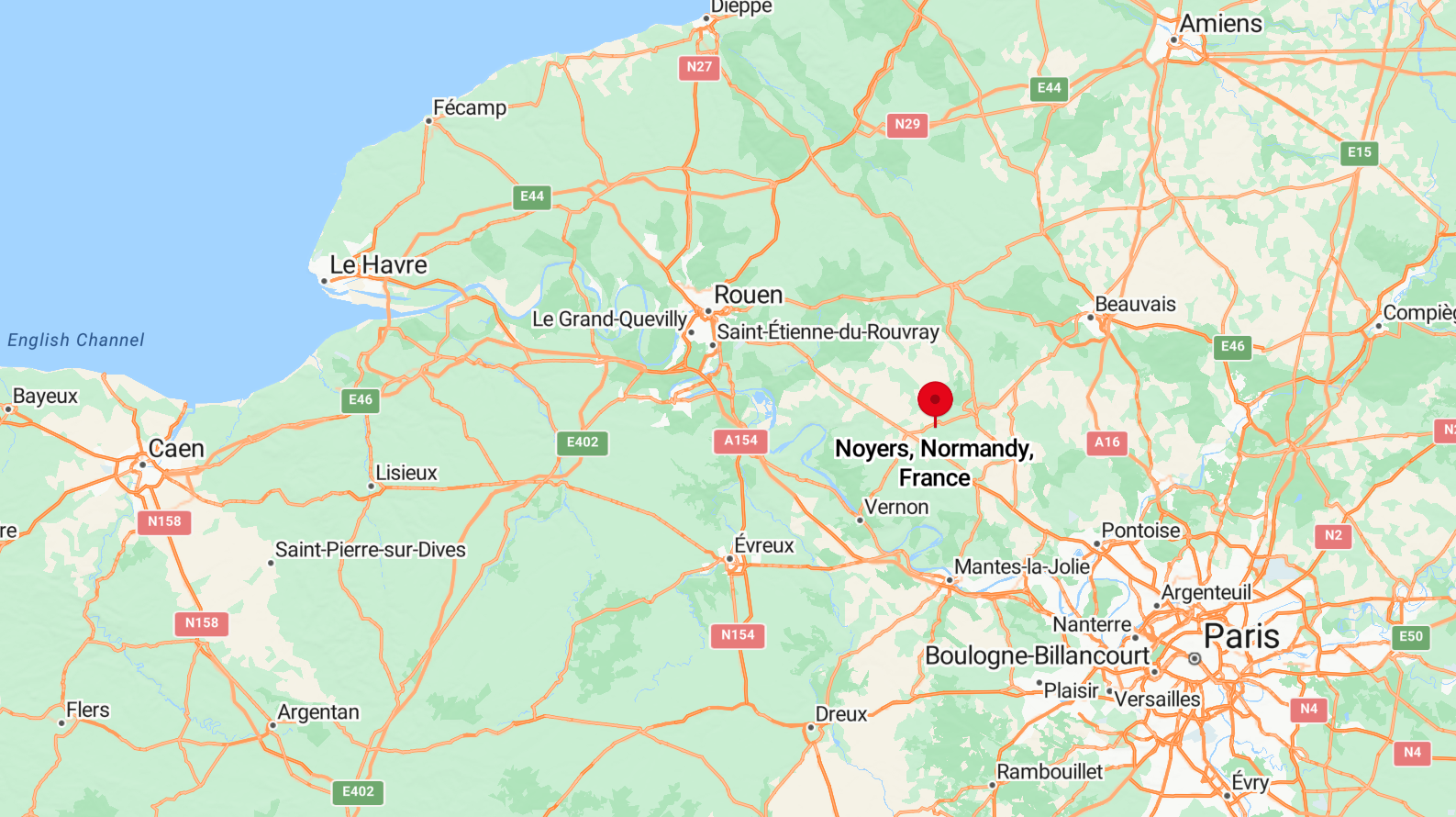
As discussed earlier, surnames were only just beginning to be used in the 11th and 12th centuries; most people were referred to as John from some town (de Noyers in Norman French) or John the Smith (blacksmith).
There are records from Normandy to support the view that the family had its origins there. Here are a few:
- Gilbert de Noyers witnessed a charter of Duke Richard to Fontanelles in 1024 A.D.
- Robert de Nodaris (or Nowers) who was Bishop of Bayeux at the time of the Domesday Book (1086)
While there is no evidence to suggest any connection to my ancestors, it is interesting to look at some of the people through the ages who have carried the name Noers, Norreys, Norris or Nurse. This is the subject of the next chapter (see Chapter 2).
1.4 The Geographical Distribution of the Nurse Surname
In the previous section I described the Etymological origins of the surname Nurse. I will now describe my research on the geographical distribution of the name.
One of the benefits of major online Genealogical resource sites like (“Ancestry.com” 2023) and (“Find My Past” 2023) is that there are now quite a lot of complete nation-wide data sets that can be used in order to analyse the distribution of family names. It takes a bit of work but the data can be gathered and analysed quite easily
The first step in locating the geographical home of a family name is to establish the current distribution. It is surprising how often family names, even after all the mobility of modern times, are still rooted in or near the places where they were first recorded in the Middle Ages. I therefore start the analysis with a recent data set (2005) of the registered voters for the UK. (“UK, Electoral Registers, 2003-2010” 2018) This data set should contain most of the adult population over the age of 18.
The data is plotted by Ceremonial County (see Figure 1.5). The mapping software (“MapChart.net” 2023) offered the possibility of a number of different Uk maps. As the data was from a modern data-set it made sense to use the modern Ceremonial Counties of England and Wales for the chart.6 The data is plotted as the number of Nurse registered voters in a particular county divided by an estimate of the total number of registered voters.7

While the effects of mobility for about 100 years is quite clear as almost every county in the country has at least 1 Nurse registered voter, the notable exceptions being Herefordshire and the City of London, there are three areas where the Nurse name is concentrated.
These are:
- a group of counties in the East of England, most notably the counties of Norfolk (207/million), Leicestershire (137/million) and to a lesser degree Suffolk (91/million).
- South Wales with the 4 counties having an average of 150/million
- Bristol (255/million) and Somerset (110/million).
Although Bristol has the largest number of Nurses per population, Norfolk actually has the largest number in absolute terms (141 vs 89)8
The next step in determining the geographical source of a family name is to use older record sources. One obvious set of sources are the censuses taken every 10 years starting in 1841.9 Rather than jumping back over a hundred years there was a pseudo-census carried out in 1939 that we can use - the so-called England and Wales Register of 1939 - which is available on Ancestry (see “1939 England and Wales Register” [1939] 2017). In this case (see Figure 1.6) the data was plotted as the number of Nurses in a particular county divided by an estimate of the county’s population10 using a map of the Historic Counties of England and Wales (see “Historic Counties of England” 2023)
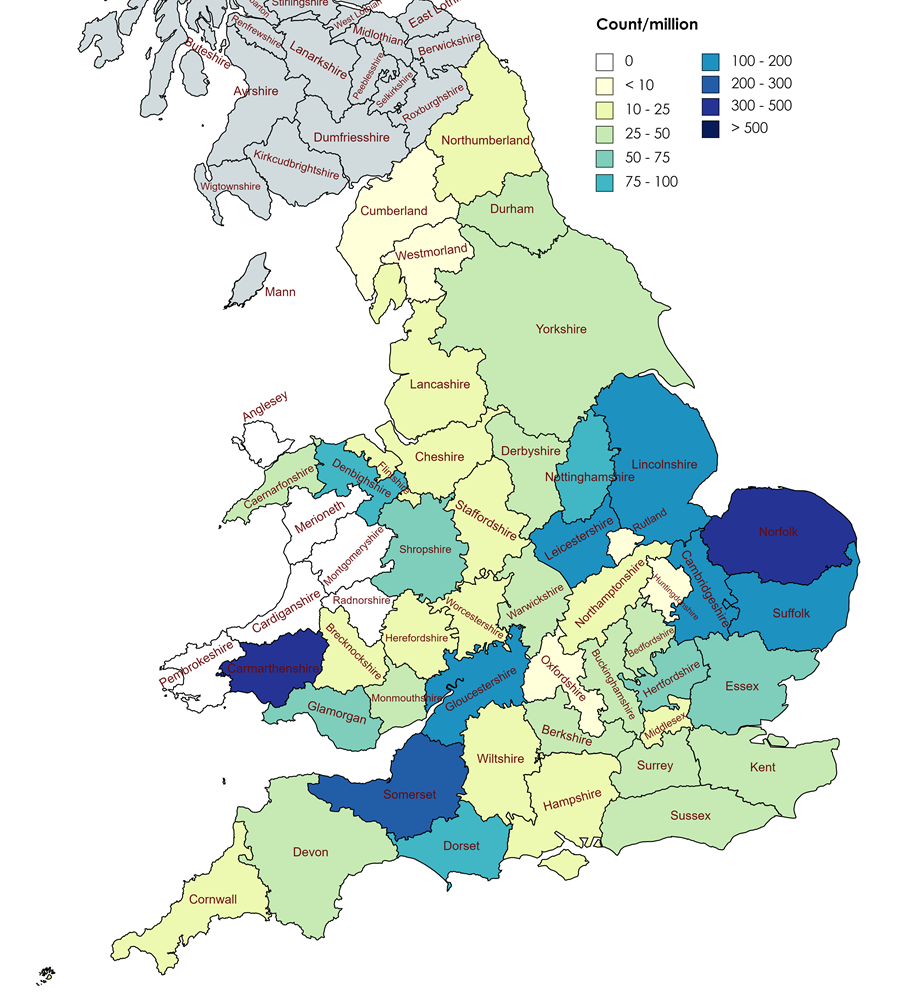
It is clear from this map that, although every english county has at least one Nurse, the three clusters of Nurses were even more evident 80 years ago.
- The largest group of Nurses is in 5 counties (Lincolnshire, Leicestershire, Cambridgeshire, Norfolk and Suffolk) in the east of England which represents just over 25% (434) of the total, of which over half are found in Norfolk (13% or 234)
- The next largest group of Nurses is in 3 counties (Gloucestershire, Somerset and Dorset) in the west of England which represents just over 14% (249) of the total, over half of whom (8% or 134)are found in Gloucestershire which includes most of Bristol
- The third group of Nurses is in 2 counties in South Wales (Carmarthenshire and Glamorgan) which represents about 7% of the total.
These three groups of Nurses represents nearly half of the total, with the rest spread throughout the country.
Next we can look at the 1851 census (“1851 England Census” [1851] 2005; and “1851 Wales Census” [1851] 2005), which pushes our analysis back nearly 90 years. As before the count of Nurses is plotted (Figure 1.7) by Historic County against the population as measured in the Census.11
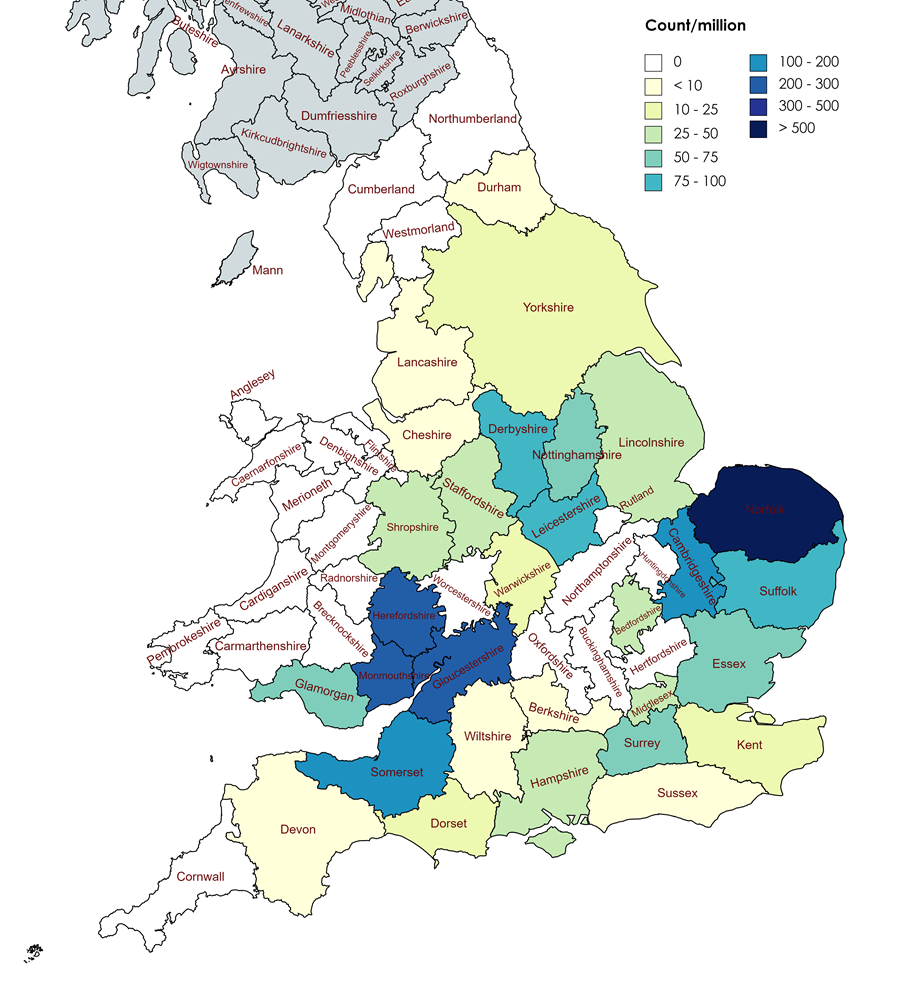
This time the groups have coalesced significantly and there really are only two groups of Nurses.
- The largest group is again based on Norfolk. In fact it really is just Norfolk, which has 335 Nurses, which represents on its own over 35% of the total.
- The second largest group is that represented by Gloucestershire (108 or 11.4%) and Somerset (71 or 7.5%) for a total of 179 (or 19% of the total). While this group could contain the counties of Herefordshire and Monmouthshire based on the count/million, their contribution is quite small due to the small populations of those counties which magnify the contribution in the chart.
Let’s look at these two regions in more detail, starting with the cluster based on Norfolk.
While there are concentrations of Nurses throughout Norfolk, Suffolk and Northern Cambridgeshire, the largest concentrations are centred on King’s Lynn and Downham Market, and Weybourne on the North Coast. In particular there are five large clusters of Nurses:
- 62 within 2 miles of Weybourne
- 27 in King’s Lynn
- 29 in and around Dersingham, about 6 miles north east of King’s Lynn
- 23 in and around Wisbech in Cambridgeshire about 8 miles to the south west of King’s Lynn, and by far the largest group
- 80 in the triangle bounded by Downham Market, Swaffham and Thetford, about 10 miles slightly west of south of King’s Lynn
In fact of the 359 (38%) of the Nurses in the 1851 Census in Norfolk and Cambridgeshire, 159 (17%) are located within 12-15 miles of King’s Lynn.
Turning our attention to the group in Gloucestershire and Somerset, we can identify 4 clusters of Nurses
- 34 centred on Hanham, Bitton and Oldland, and the western environs of Bristol
- 27 south of Bristol in Bedminster, Dundry and Compton Dando
- 34 in the area of Somerset between Shepton Mallet and Wells, and
- 39 centred on Stroud and Stonehouse in Gloucestershire
In 1851, most (if not all) of the Nurses in the Hanham/Bitton area are my ancestors and their descendants, as are many of those in the group to the south of Bristol.
To conclude this discussion, we can postulate two scenarios;
- the name originated in a few locations independently, or
- the name originated in one location and a descendant moved to the second location, where the family prospered.
Prior to the national censuses of the 19th century there are no sets of data that are as complete. We are therefore left with these two scenarios.
Since I have been able to trace my Nurse ancestry back to the late 17th century to Chew Magna in North Somerset, it is likely that my Nurse line originated somewhere in Somerset.